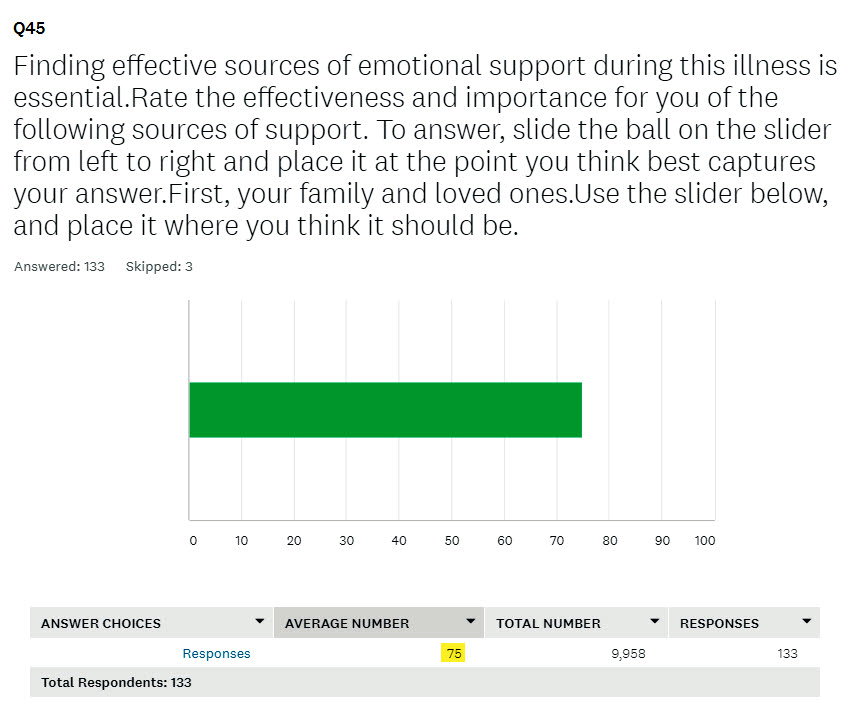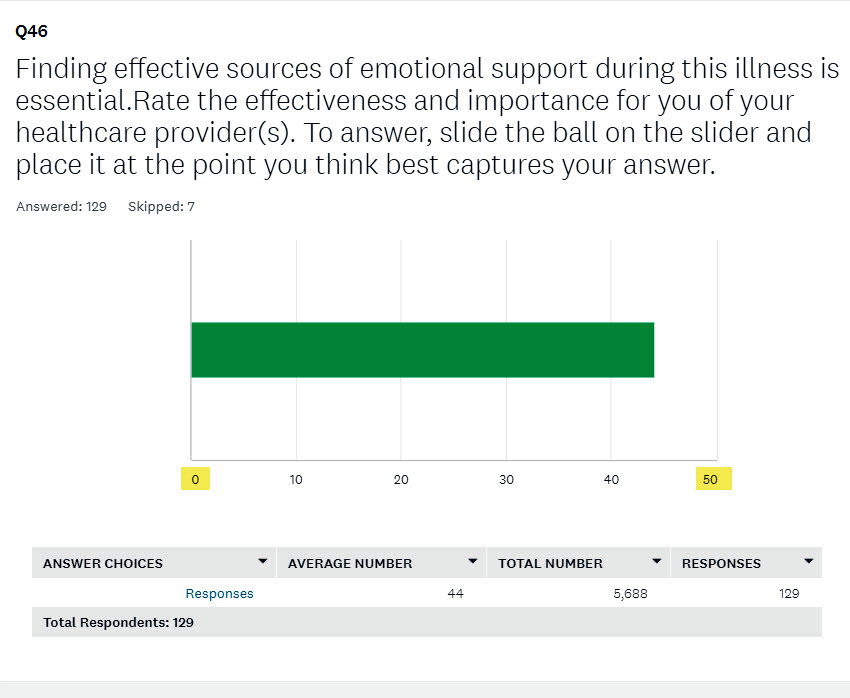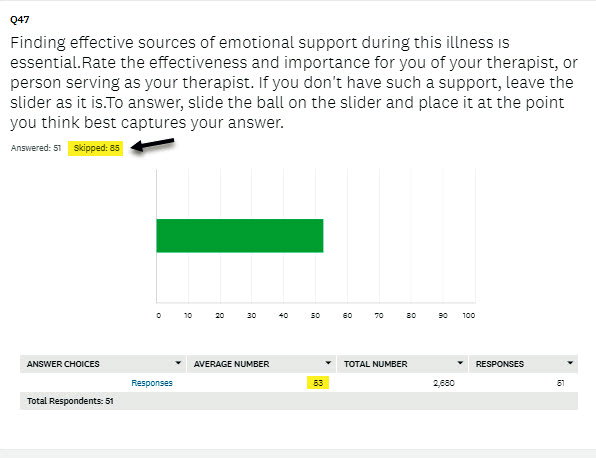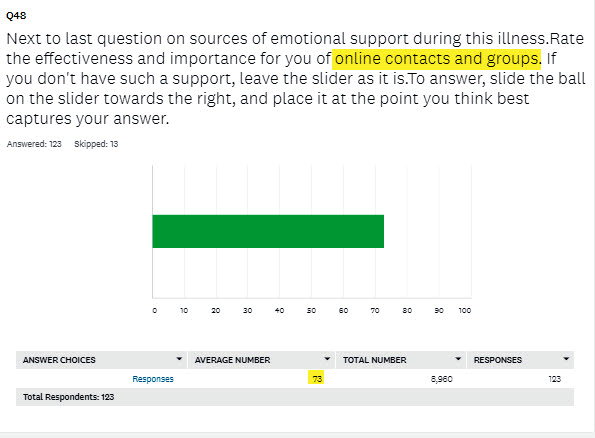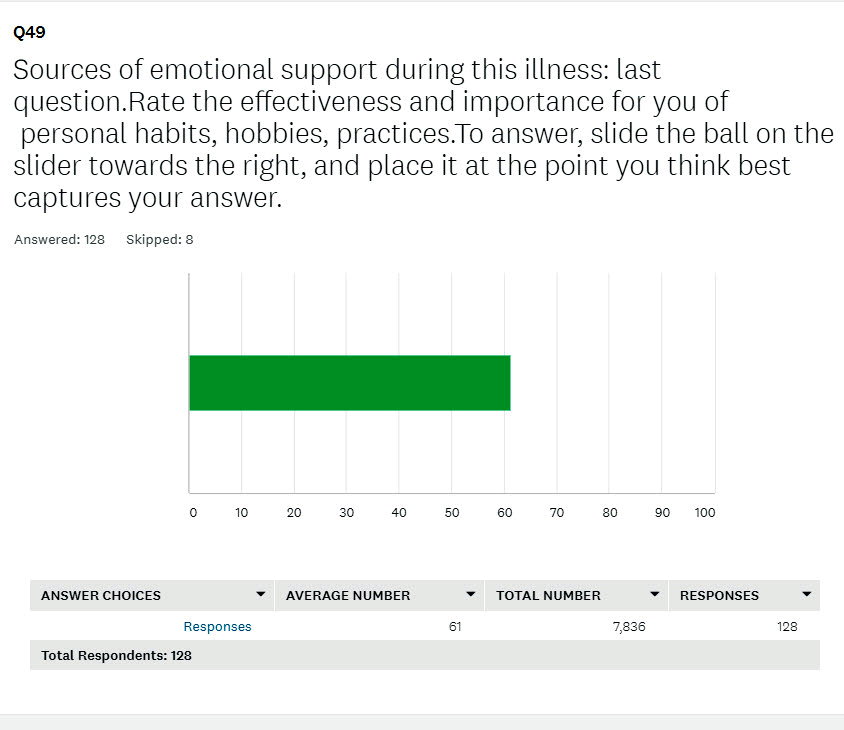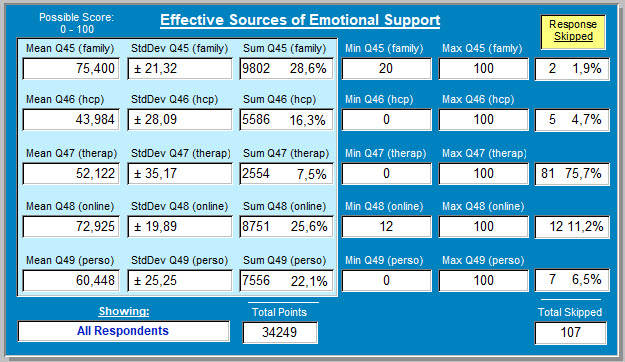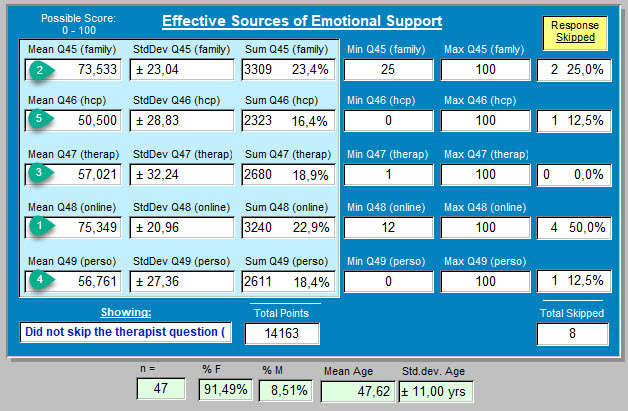Q. 45, 46, 47, 48, 49 - Sources of effective emotional support
LTCOVID.com
Thanks for visiting!
To translate this page, select your
language from the dropdown menu below:
We have combined here 5 questions that all pertain to findig effective emtional support in this setting of "long-term" COVID-19.
The questions are presented here to get a sense of how they were phrased, along with their numerical results.
Each asked for an assessment of how effective a source of potential emotional support actually proved to be.
These sources are:
- family and loved ones
- healthcare provider(s)
- a therapist or person serving as a therapist
- online contacts and groups
- personal habits, hobbies and practices.
As explained in each of these questions, a numerical value from 0 to 100 was generated using a slider as a tool in the questionnaire's graphic interface. This creates a continuous scale of values, instead of a Likert discontinuous scale. It's utility and value has already been well studied in the relevant literature on testing methods.
This teaches that family, as source of emotional support scored an average of 75 points on the slider's scale of 0 to 100. The 133 responses generated a total of 9,958 "points" if one wants to think of them that way.
One these grouped questions have been presented, a panel comparing more easily these results will follow.
Notice that the host of the questionnaire has changed the scale that was 0 - 100, to 0 -50 here!
That can be visually misleading. But the numeric values are correct: 44 points (on the 0 - 100 scale) on average and a total of 5,688 for effectiveness of emotional support from health-care providers, obtained from these 129 respondents. (7 skipped).
Next question: therapists as sources of effective emotional support in the setting of "long-term" COVID-19 ...
Back to the 0 - 100 scoring scale.
Notice: more skips of the question, and fewer points awarded. More comments will follow below.
Online groups as source of emotional support averaged 73 points, and a total of 5,960.
123 respondents answered, and 13 skipped the question.
And finally, personal habits, hobbies and practices as effective in meeting emotional needs ...
Let's combine these results to facilitate comparison:
In the light blue box at the left, the scores for each of the 5 potential sources of support. These values on the scale of 0 - 100 are means with standard deviations. Adjacent, the total points awarded (34,249) and each result expressed as a percent of the whole.
More to the right, the range of scores given, and under the yellow sign, a summary of the number and percent of respondents that skipped the question. For the 5 questions these total 107 skips.
Clearly, most (76%) skipped the question of effectiveness of emotional support of a therapist or "person serving as your therapist" as the question phrased it. While this characterization is a little vague, it didn't change the fact that most did not respond. We'll leave the question, "Why?" as open ended.
To allow for a fair comparison of effectiveness, the same results are now presented after eliminating the large number who skipped the therapist question.
Notice the characteristics of the sample included at the bottom of the graphic in the light green boxes. 47 respondents, with a gender distribution and mean age still very close to the entire sample.
"So who won?"
While it isn't really a contest, the green numbers on the left help to answer the question:
- Online groups
- Family, a close second
- Therapists
- Personal habits & practices
- Health-care provider(s) (who come in last)
Their mean score for the health-care provider question is not statistically distinct from the mean for either Personal Habits nor Therapists.
But as one might guess, even with the reduced sample size of 47 respondents, the mean score for family as effective source of emotional support is distinct from that of the health-care provider(s):
t-score = 4.2787 df = 92 SE of diff. = 5.383 and p = 0.0001.
Without belabouring the statistics, the result for the comparison of means with our winner, online groups, gives this: t-score = 4.7794 df = 92 SE diff. = 5.383 p = 0.0001
But of course, this should not be a contest at all.
Ideally, all five sources of might effectively work together in complement, providing emotional support for those presenting with "long-term" COVID-19.
That online groups beat out the four others, all scored by the same respondent, demands some reflection. Why have the others been replaced? And if "replaced" is too strong a conclusion, what has contributed to reducing their effectiveness?
In addition to their actual family, these respondents seem to have a new family: online groups.
A striking result.
That health-care providers took a beating, again seems to suggest a need for further explanation.
We'll save that for a subsequent question where respondents wrote out feedback for this group.
These results begin to support a hypothesis that it's time for a change in today's patient-physician relationship. Did the large number of unknowns that came along with "long-term" COVID-19 create this?
Or did it simply unmask issues that were, and perhaps for too long, already there ?
Some might answer: "The system works, just not for these patients."
We would respond that if that is the case, the system needs some thoughful yet speedy adjustment.
<<<< Previous page
Q. 50 - Response of family members >>>>>
A découvrir aussi
- Q. 16 - Nutritional supplements, including Vitamin D: use before
- Q. 18 - Which medications actually taken for COVID-19?
- Q. 60 - Thank you and possible feedback

